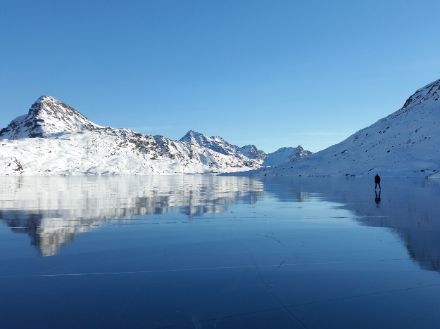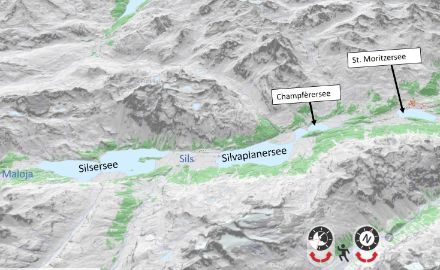Service Navigation
Search
How black ice is formed
A lake always freezes first at its surface. This is due to a special characteristic of water, which reaches its highest density at four degrees Celsius, and not, as is the case with other liquids, as soon as it reaches its freezing point.
Before water can begin to freeze, the entire volume of the lake has to first cool down to four degrees, after which the layer of water closest to the surface cools down further. Because it has a lower density, this layer will no longer sink.
While the water at the bottom of the lake remains at four degrees Celsius, the temperature at the surface quickly reaches freezing point. If the surface temperature sinks below zero, the water begins to freeze.
If no precipitation falls while the lake is freezing over, black ice forms. The less disturbed the lake surface is (i.e. the less wind and water currents), the smoother, more uniform and more transparent the ice.

Black ice on the Upper Engadine mountain lakes
The conditions in the Engadine lake region are ideal for the formation of black ice. This high Alpine valley gets exceptionally cold, especially during the winter months, thanks to the frequent formation of cold air pools. Furthermore, precipitation is relatively scarce due to the valley being surrounded by higher mountain ranges on nearly all sides, which offer some protection.
On the larger lakes in the Upper Engadine, a thin layer of ice often forms as early as the first half of January. While Lake St. Moritz and Lake Champfèr typically freeze over in December, it takes a little longer for Lake Sils, due to its larger size. The last lake to freeze over is usually Lake Silvaplana, which is deeper in many parts than the other lakes.

The timings of when the individual lakes freeze over vary widely
The cumulative time during which the air temperature is significantly colder than the water temperature is the determining factor when it comes to the freezing over of a lake. This means that even in the autumn months, the weather plays a decisive part in how quickly the lakes freeze. If the autumn and start of winter have been warmer than usual, the freezing process can be delayed by several weeks.
Once the water has reached four degrees Celsius throughout the entire volume of the lake, it usually doesn’t take long for a solid ice cover to form. Often, just a handful of calm and cold days are enough.
There are exceptions, however:
In the winter of 2022/2023, the freezing process on Lake Sils did not begin until mid-January, and it was February by the time the lake was fully covered in ice. The reason for the delayed freezing was an extended period of strong north winds. The wind caused the cold surface water to be partially mixed and driven away. As a result, warmer water from the depths was brought to the surface. This can delay or even halt the freezing process. In addition, it was much milder than usual during this period.